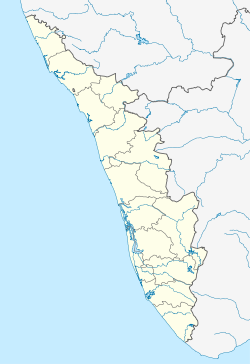- Dutch Malabar
-
Dutch Malabar
MalabarDutch colony ← 
1661–1795  →
→

Flag Coat of arms Capital Quilon (1661-1663)
Cochin (1663-1795)Language(s) Dutch, Malayalam Political structure Colony Commander - 1663-1665 Ludolph van Coulster - 1669-1676 Hendrik van Rheede - 1793-1795 Jan Lambertus van Spall Historical era Imperialism - Dutch capture of Quilon December 1661 - British annexation of Malabar 1795 Malabar, also known by the name of its main settlement Cochin, was a commandment of the Dutch East India Company on the Malabar Coast between 1661 and 1795, and is part of what is today collectively referred to as Dutch India. Dutch presence in the region started by the capture of Quilon from the Portuguese, and ended by the occupation of Malabar by the British in 1795.[1]
Contents
History
Although also motivated by the lucrative pepper trade on Malabar, the primary aim for the Dutch in capturing the coast from the Portuguese was to secure Dutch Ceylon from Portuguese invasions. After failed attempts to capture the main Portuguese fort Goa in 1604 and 1639, the Dutch decided to aim for the secondary Portuguese trading posts on the Malabar Coast. This was first successful in December 1661, when Quilon was captured. A little more than a year later, in January 1663, Cochin was captured as well, which now became the primary trading post of the colony. In 1669, Dutch Malabar became a separate commandment of the Dutch West India Company; before this year it had been governed from Batavia.[1]
The Dutch never succeeded in establishing a pepper trade monopoly in Malabar, and were all the more frustrated in their attempts when the raj of Travancore started to expand his kingdom. The Travancore–Dutch War that followed culminated into the Battle of Colachel, which was disastrous for the Dutch.
As a result of the Kew Letters, the Dutch settlements on the Malabar Coast were surrendered to the British in 1795, in order to prevent being overrun by the French. Dutch Malabar remained British after the conclusion of the Anglo-Dutch Treaty of 1814, which traded the colony with Bangka Island.
Forts and trading posts
Settlement Type Established Disestablished Comments Fort Cochin Fort and factory 1663 1795 Established by the Portuguese as their first settlement in India. Captured by the Dutch in 1663, who made it the capital of Dutch Malabar. Fort Cranganore Fort 1662 1770 Fell under the command of Fort Cochin and meant to protect the latter. In 1662, the formerly Portuguese fort was first given back to the Zamorin of Calicut as a reward for his alliance with the Dutch, but in 1666 the Dutch started to renovate the dilapidated fort for their own purposes. Fort Pallipuram Fort 1661 1789 Fell under the command of Fort Cochin and meant to protect the latter. Sold to the Kingdom of Travancore in 1789. Purakkad Factory 1662 ? Fell under the command of Fort Cochin. Fort Quilon Fort and factory 1661 1795 The first Portuguese fort to be captured by the Dutch in December 1661. Capital of Dutch Malabar until the capture of Cochin in 1663. Kayamkulam Factory 1661 ? Fell under the command of Fort Quilon. Fort Cannanore Fort and factory 1663 1790 Captured on 15 February 1663 from the Portuguese. Vengurla Factory 1637 1693 Established before the establishment of the Malabar commandment to spy on the nearby Portuguese settlement of Goa. Fell directly under the command of Batavia until 1673, and then under command of Suratte. From 1676 onwards, the command was with Dutch Malabar. Barselor Factory 1667 1682 Established by treaty with the local ruler. The unreinforced factory traded in rice and pepper, and was closed in 1682 after problems with local merchants. Gallery
-
The Bolgatty Palace, built in 1744 for the commander of Dutch Malabar, is one of the oldest existing Dutch palaces outside of the Netherlands.
See also
- List of commanders of Dutch Malabar
- Dutch Ceylon
- Dutch Coromandel
References
Dutch Empire Colonies and trading posts of the Dutch East India Company (1602-1798) GovernoratesAmbon · Banda · Batavia · Cape Colony · Ceylon · Coromandel · Formosa · Northeast coast of Java · Makassar · Malacca · MoluccasDirectoratesCommandmentsResidenciesSettlements with an opperhoofdColonies and trading posts of the Dutch West India Company (1621-1792) Colonies in the AmericasAcadia · Berbice† · Cayenne · Curaçao and Dependencies · Demerara · Essequibo · Brazil · New Netherland · Pomeroon · Sint Eustatius and Dependencies · Suriname‡ · Tobago · Virgin IslandsTrading posts in Africa† Governed by the Society of Berbice · ‡ Governed by the Society of Suriname Settlements of the Noordsche Compagnie (1614-1642) SettlementsColonies of the Kingdom of the Netherlands (1815-1962) Until 1825Until 1853Until 1872Until 1945Until 1954Until 1962† Became constituent countries of the Kingdom of the Netherlands; Suriname gained full independence in 1975, Curaçao and Dependencies was renamed to the Netherlands Antilles, which was eventually dissolved in 2010. Kingdom of the Netherlands (1954-Present) Constituent countriesPublic bodies of the NetherlandsCategories:- Former countries in South Asia
- Former Dutch colonies
- States and territories established in 1661
- States and territories disestablished in 1795
- Dutch India
- European colonisation in Asia
- History of Kerala
Wikimedia Foundation. 2010.






